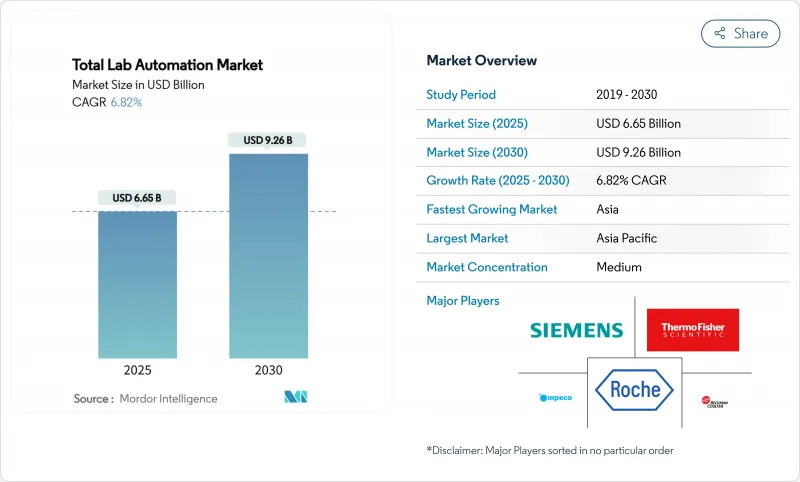
|
市場調査レポート
商品コード
1851418
トータルラボオートメーション:市場シェア分析、産業動向、統計、成長予測(2025年~2030年)Total Lab Automation - Market Share Analysis, Industry Trends & Statistics, Growth Forecasts (2025 - 2030) |
||||||
カスタマイズ可能
適宜更新あり
|
|||||||
| トータルラボオートメーション:市場シェア分析、産業動向、統計、成長予測(2025年~2030年) |
|
出版日: 2025年07月06日
発行: Mordor Intelligence
ページ情報: 英文 120 Pages
納期: 2~3営業日
|
概要
トータルラボオートメーション市場の2025年の市場規模は66億5,000万米ドルで、2030年には92億6,000万米ドルに達し、CAGR 6.82%で成長すると予測されています。

この市場拡大は、創薬のためのハイスループットスクリーニングの急増、診断検査量の急増、臨床・研究現場におけるエラー最小化の優先度の高まりによって推進されています。ロボット工学、人工知能、クラウド接続は現在、ラボがワークフローを最適化し、機器の故障を予測し、大規模なデータセットをリアルタイムで分析できるようにする完全に統合されたプラットフォームに集約されています。モジュラー設計へのシフトは、小規模施設が完全な「アイランド」にコミットすることなく自動化を導入するのに役立ち、一方で協働ロボットの普及は、対応可能なユーザーベースを広げています。精密医療への関心の高まり、規制の厳格化、細胞・遺伝子治療製造の急速なスケールアップも、トータルラボオートメーション市場全体で機器のアップグレードや新規導入を加速させています。
世界のトータルラボオートメーション市場の動向と洞察
AIを活用した予知保全の統合によるダウンタイムの最小化
プロアクティブ・アナリティクスは現在、温度、圧力、振動、モーター負荷を数千のデータポイントにわたって監視し、故障の数時間前に異常を発見します。ハイスループットの臨床ラボでは、これらのアルゴリズムをリキッドハンドラーとトラックシステムに組み込んだ後、予定外の停止が最大30%減少し、資産寿命が15~20%延びたと報告しています。サービスコールは減少し、試薬の廃棄は減少し、スケジューリングはより予測可能になり、資産利用率を直接向上させます。ベンダーのダッシュボードは、モバイルアラートを通じて技術者に情報を提供し続け、多くの介入を数時間ではなく数分で完了できるようにします。北米では、これらの利益はROIサイクルを短縮し、自動化アップグレードの次の波に対してより強力な財務的ケースを作る。
臨床診断におけるEU IVDR主導のアップグレードサイクル
欧州ではIVDDからIVDRへの移行により、文書化、トレーサビリティ、性能エビデンスの要件が強化され、検査室は老朽化したシステムを、すべてのステップを記録する自動化されたソリューションに置き換える必要に迫られています。ミドルウェアは現在、コンプライアンス・レポートを自動生成し、手作業による事務処理と監査リスクを軽減しています。ベンダーは、バーコード付き試験管をクラウドリポジトリにリンクする分析装置トラックで対応し、分析前、分析、分析後の各段階におけるデータの完全性を確保しています。2028年の移行マイルストーンが近づくにつれ、ドイツ、フランス、英国の調達パイプラインは、規制に基づいて認証された次世代プラットフォームで満たされつつあります。適合するハードウェアとソフトウェアへの奔走が、トータルラボオートメーション市場全体の短期需要を牽引しています。
真のTLAアイランドには7桁のCAPEXと長いROIが必要
分析前、コアラボ、分析後の各段階を統合する包括的なアイランドは、100万米ドルをはるかに超える費用がかかることが多く、設置には9カ月を超える期間がかかります。小規模の病院やアカデミックラボでは、年間検査数が控えめな場合、出費を正当化するのに苦労します。融資パッケージやサンプルごとの支払いモデルも出てきているが、多くの地域ではまだ限定的です。予算が承認されたとしても、検証や冗長計画に時間がかかり、収益の実現が遅れます。このような力学が、トータルラボオートメーション市場において最も統合されたフォーマットの短期的な浸透を妨げています。
セグメント分析
自動リキッドハンドラーは最大の収益を生み出し、2024年のトータルラボオートメーション市場シェアの32%を確保しました。その正確な吸引と分注機能は、診断、創薬、学術研究におけるアッセイの信頼性を支えています。高度なモデルは、圧力ベースのレベルセンシングとクロスコンタミネーションチェックを備えており、ハイスループット・プラットフォームの中核としての地位を強化しています。精密医療プログラムにおいてサンプル数が増加するにつれ、より高速なデッキ構成とデッキ上でのインキュベーションに対する需要が高まり、このカテゴリーはより幅広いトータルラボオートメーション市場の先頭に立ち続けています。
ロボットアームは、ベースは小さいもの、CAGR 8.8%で拡大しています。コンパクトな6軸のデザインは、現在ではバイオセーフティキャビネット内に取り付けられ、インキュベーター、イメージャー、遠心分離機の間で、人が触れることなくプレートの受け渡しを行う。新しいグリッパー技術は、クライオバイアルや細胞培養フラスコを扱い、その範囲を広げています。協働型は、技術者が手動で動作を教えることを可能にし、プログラミングのオーバーヘッドを削減します。柔軟性の向上と価格の下落が、中規模ラボでの採用を促進し、トータルラボオートメーション市場全体の成長に勢いを与えています。
LIMSは、2024年のトータルラボオートメーション市場規模の38%をソフトウェア層で占めています。運用のバックボーンとして機能する最新のプラットフォームは、サンプルの受入、CoC、機器のスケジューリング、規制当局への報告などを管理します。最近のリリースでは、ボトルネックにフラグを立て、レシピの微調整を推奨するAIモジュールを組み込み、LIMSを受動的なデータベースではなくリアルタイムの最適化エンジンに変えています。統合APIは現在、病院の電子記録や製造実行システムに直接リンクし、LIMSをデジタルヘルスインフラストラクチャの中心ノードとして位置づけています。
科学データ管理システムは、CAGR10.2%で最も急速に進歩しました。爆発的に増加するマルチオミクスデータセットは、イメージングや高コンテンツスクリーンと相まって、スプレッドシートベースのアーカイブの容量を超えます。SDMSソリューションは、自動化されたメタデータの取り込み、バージョン管理、監査証跡を活用し、規制当局と研究の再現性の両方を満足させる。機械学習の拡張機能により、生のクロマトグラムや遺伝子発現マトリックスから数分で洞察を引き出し、意思決定までの時間を短縮します。クラウドストレージのコストが低下し続ける中、サブスクリプションベースのSDMSの普及はトータルラボオートメーション市場にとって力強い追い風であり続けると思われます。
ラボラトリーオートメーション市場レポートは、業界を機器タイプ(自動液体ハンドラーなど)、オートメーション範囲(前処理自動化など)、ソフトウェア(ラボラトリー情報管理システムなど)、アプリケーション(創薬、ゲノムなど)、エンドユーザー(製薬会社、バイオテクノロジー会社など)、地域に分類しています。市場予測は金額(米ドル)で提供されます。
地域分析
北米は2024年のトータルラボオートメーション市場シェアの41%を占め、豊富な臨床研究予算、大規模なリファレンスラボ、AI予知保全の早期導入に支えられています。機器ベンダーは現場での分析サポートを提供し、価値実現までの時間を短縮しています。また、医療ネットワーク間でのリアルタイムのデータ交換を奨励する連邦政府のイニシアチブも採用を後押ししています。精密腫瘍学を推進するカナダと拡大するメキシコの民間病院セクターは補完的な追い風となり、この地域の収益をさらに押し上げます。
欧州は第2位で、検査施設にデータ収集とトレーサビリティの近代化を迫るIVDR移行によって成長を形成しています。ドイツ、英国、フランスが導入の先陣を切っており、多くの場合、複数の病院にサービスを提供する集中化されたコアラボハブに自動化を統合しています。官民のゲノミクスプログラムは、標準化されたサンプルハンドリングを要求し、バイオバンクの自動化に新たな息吹を吹き込みます。東欧諸国は、欧州構造基金を活用し、大陸のデータ管理規則に合わせてレガシーミドルウェアを置き換え、トータルラボオートメーション市場の地域的浸透を広げています。
アジア太平洋地域は最も急速に成長しており、2030年までのCAGRは7.9%です。中国のスマートホスピタルの青写真には、ロボットトラックを義務付けることが含まれており、国内生産と欧米のサプライヤーとの合弁事業に拍車をかけています。日本は手狭な都市施設に適合するスペース効率の高いロボットを重視し、韓国は政府補助金によってハイスループット・ワクチンの研究開発を加速させています。インドでは、グローバルなCROへの投資と、標準化されたワークフローを求める州レベルの医療スキーム研究所という2つの原動力が存在します。地域のサプライチェーンが成熟するにつれて、コスト効率の高いプラットフォームが東南アジアの新興経済圏でシェアを拡大する可能性が高いです。
その他の特典:
- エクセル形式の市場予測(ME)シート
- 3ヶ月のアナリストサポート
よくあるご質問
目次
第1章 イントロダクション
- 調査の前提条件と市場の定義
- 調査範囲
第2章 調査手法
第3章 エグゼクティブサマリー
第4章 市場情勢
- 市場概要
- 市場促進要因
- AIを活用した予知保全の統合によるダウンタイムの最小化
- 臨床診断におけるEU IVDR主導のアップグレードサイクル
- 細胞・遺伝子治療製造におけるハイスループットQCの必要性
- 分散型・バーチャル臨床試験マイクロラボの出現
- 超低温自動保存を求めるバイオバンク量の増加
- 政府資金によるスマート病院の建設(GCCと中国)
- 市場抑制要因
- 真のTLAアイランドのための7桁のCAPEXと長いROI
- レガシーミドルウェアと次世代分析装置との相互運用性のギャップ
- サイバーセキュリティとデータ主権コンプライアンスの負担
- 精密メカトロニクス部品におけるサプライチェーンの変動性
- バリュー/サプライチェーン分析
- 規制・技術的展望
- ポーターのファイブフォース分析
- 競争企業間の敵対関係
- 新規参入業者の脅威
- 代替品の脅威
- 買い手の交渉力
- 供給企業の交渉力
第5章 市場規模と成長予測
- 機器別
- 自動リキッドハンドラー
- ロボットアーム
- 自動保管・検索システム
- 臨床化学と免疫分析装置
- 自動プレートハンドラ
- ソフトウェア別
- ラボ情報管理システム(LIMS)
- 科学データ管理システム(SDMS)
- 電子実験ノート(ELN)
- ラボ情報システム(LIS)
- クロマトグラフィーデータシステム(CDS)
- オートメーション範囲別
- 前処理自動化
- 分析/コアラボ自動化
- ポスト分析オートメーション
- トータルラボオートメーション(TLA)アイランド
- 用途別
- 臨床診断
- ゲノミクス
- 創薬
- プロテオミクスとメタボロミクス
- バイオバンクとサンプル管理
- エンドユーザー別
- 製薬・バイオテクノロジー企業
- 研究・製造受託機関(CROs/CDMOs)
- 病院および診断リファレンスラボ
- 学術・政府機関
- 地域別
- 北米
- 米国
- カナダ
- メキシコ
- 南米
- ブラジル
- アルゼンチン
- その他南米
- 欧州
- ドイツ
- 英国
- フランス
- イタリア
- スペイン
- その他欧州地域
- 中東
- GCC
- トルコ
- その他中東
- アフリカ
- 南アフリカ
- ナイジェリア
- その他アフリカ
- アジア太平洋地域
- 中国
- 日本
- インド
- 韓国
- 東南アジア
- その他アジア太平洋地域
- 北米
第6章 競合情勢
- 市場集中度
- 戦略的動向
- 市場シェア分析
- 企業プロファイル
- Thermo Fisher Scientific Inc.
- Danaher Corp.(Beckman Coulter)
- Roche Diagnostics International AG
- Siemens Healthineers AG
- Abbott Laboratories
- Tecan Group Ltd.
- Agilent Technologies Inc.
- PerkinElmer Inc.(Revvity)
- Bio-Rad Laboratories Inc.
- QIAGEN N.V.
- Inpeco SA
- Hamilton Company
- Hudson Robotics Inc.
- SPT Labtech Ltd.
- Swisslog Healthcare AG
- BD(Kiestra)
- LabVantage Solutions Inc.
- LabWare Inc.
- Opentrons Labworks Inc.
- Perceptive Automation LLC
- Yaskawa Electric Corp.
- Eppendorf SE
- Formulatrix Inc.
- Biosero Inc.
- Tecan Genomics Inc.


